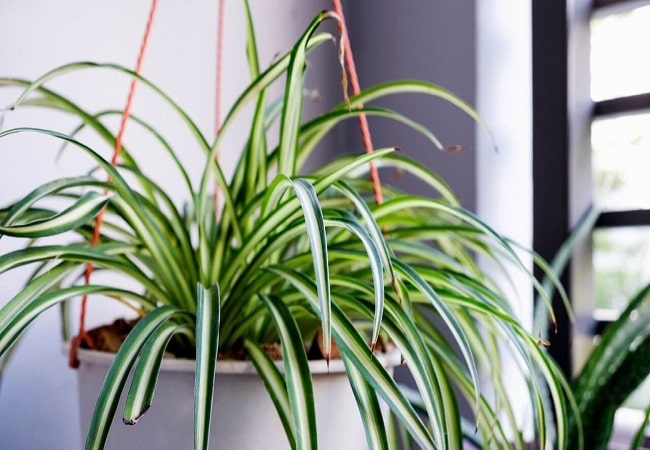Spider plants (Chlorophytum comosum) are among the most popular and versatile houseplants, cherished for their resilience, air-purifying abilities, and signature cascading foliage. As these lively plants grow and flourish, how to separate spider plants they produce offshoots called ‘spiderettes’ or ‘plantlets’ that dangle from the mother plant like spiders on a web.
Separating and propagating these spiderettes is an essential aspect of spider plant care, as it helps maintain the health of the parent plant and allows you to expand your collection of these delightful green companions. In this guide, we’ll explore the process of separating spider plants, discussing the best techniques, tools, and tips to ensure successful propagation and vibrant, healthy growth for both the parent plant and its offspring.
Quick Navigation
The Procedures For Separating Spider Plants
Spider plants can live in temperatures as low as 35 degrees Fahrenheit, but they do best in temperatures between 65 and 90 degrees.
Follow the below steps to separate your spider plant.
Take A Look At The Roots Of Your Plant

You must choose the location of your dividing before you begin. To deal with your plants without creating a mess, it would be best to do it outside; but, if you don’t mind doing some cleanup afterward, indoors is also OK.
I made the decision to divide things up inside, so I tore open a paper bag and set it down on my counter to collect the dirt.
Taking Your Plant Out Of Its Pot
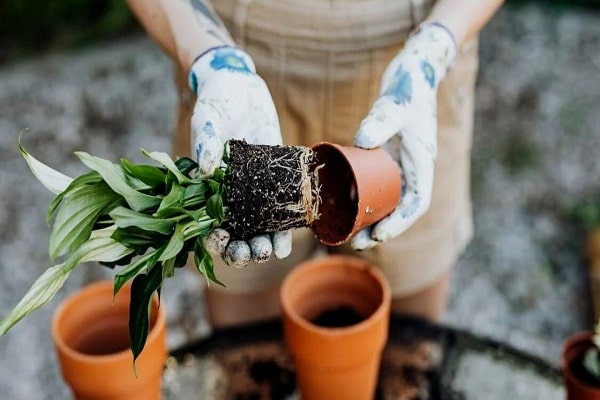
You can do a few things to get your plant out of the pot.
- If the pot is not too hard, you can start by gently squeezing the container to loosen the dirt and roots from the inside walls of the pot.
- You can use gravity to help you get the plant out of the pot if you put your hand on the top of the soil and turn the pot upside down.
- You can loosen the plant from the pot by holding the bottom of it and gently rocking it back and forth.
- You can cut the dirt and roots away from the inside wall with a butter knife, just like you do before you take a cake out of a cake pan.
Separate The Parts Of The Plant By Their Roots

Look at the roots of your plant now that it is out of the pot. To get a better look, gently pull the soil away from the roots with your fingers.
Spider plants have roots that look like pouches that hold water. These roots are called tuberous roots or tubers.
I could just pull the two sides apart, slowly at first so that the roots could untangle themselves. The root network will stay with the tubers to which it is connected.
If you can’t pull the roots apart by hand, you can cut through them with a clean knife. You don’t have to worry too much about hurting the roots because they will grow back quickly.
Fill Up Your New Pots With Soil
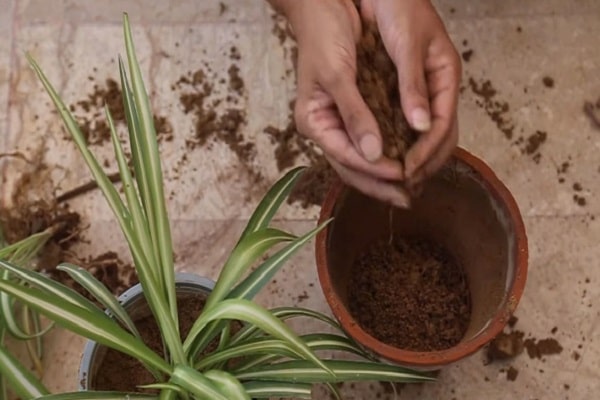
Fill each pot with at least 3 inches (7 cm) of soil. Depending on the size of the pot and root ball, you may need to add more later. The soil in the bottom should bring the plant’s roots up to the surface and give the plant plenty of room to grow.
The roots of your plant will also need space in the soil at the bottom of the pot. The roots of spider plants grow quickly, so make sure that the pot or planter you choose has room for them to grow. If you don’t, you’ll soon have to re-pot again.
Re-pot The Plants You Separated
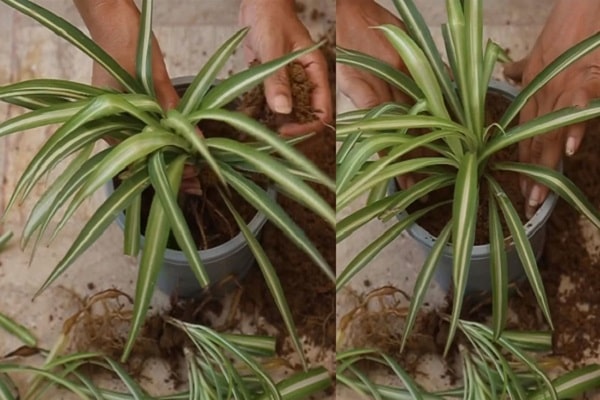
Fill the pot or planter up to the plant’s base with soil or potting mix around the roots. Gently pack the soil around the roots of your plant to make sure it has enough support.
Choose A Location For Your Plants
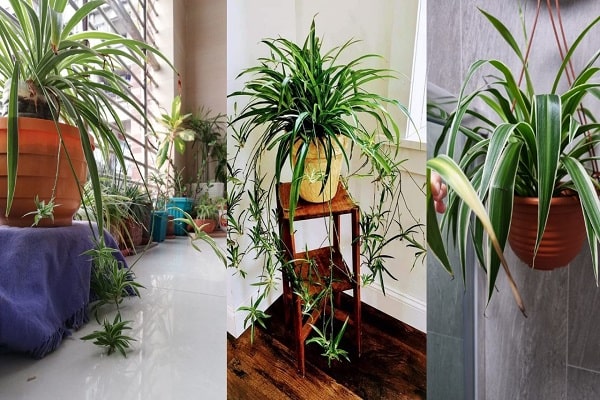
Spider plants don’t need direct sunlight. In fact, direct sunlight can burn the leaves of spider plants. Because of this, I don’t want to put them near a south-facing window like most of my other houseplants. The best thing to do is to find a good spot with indirect light.
Spider plants are great for hanging, especially ones with long, flowing leaves like these. Plants that hang from the ceiling can really bring life and color to a room. The cat can’t get to them either.
Provide Your Plants Water
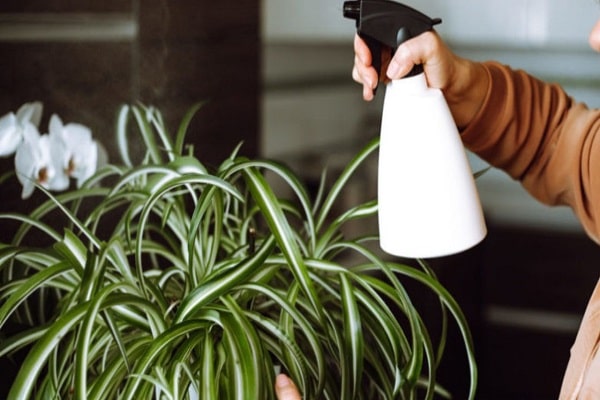
Give your newly potted plants a good soaking of water and keep the soil moist while the roots get used to the new soil. Spider plants don’t usually show any signs of stress when they are split up and put in new pots. If you look after them, they will do well in their new homes. Spider plants should be watered about once a week, on average. Check to see if the soil is dry before you water the plants.
Frequently Asked Questions
Can Spider Plants Live Outside In The Summer?
Spider plants are able to survive outside in the summertime if they are in a container that is kept moist. If the container dries out, then the plant will likely die. Spider plants do best in full sun but can tolerate some shade, as long as they are watered regularly.
How To Root Spider Plants In Water?
Rooting spider plants in water is a simple process that done at any time of the year. The best time to root spider plants in water is during the early spring when the soil is still warm and wet.
- First, clean the pot or container in which the spider plant will be planted with mild detergent and hot water.
- Next, fill the pot or container with fresh water and place the spider plant into it.
- Cover the pot or container with a lid or plastic wrap and wait until the plant roots have grown into the soil.
- Remove the plant from the pot or container and transfer it to a soil-based potting mix.
How Do You Speed Up Spider Plant Growth?
Spider plants, like most succulents, grow best when given plenty of light and water. However, there are a few techniques that are used to speed up spider plant growth.
- One is to separate spider plants into smaller groups so that they have more room to grow.
- Another is to provide them with high-quality potting soil and adequate water supply.
- Finally, they are grown in a bright location, such as a windowsill.
Should I Put Milk In My Spider Plant?
Yes, spider plants do like milk, and as strange as it may sound, milk is actually good for plants. Milk is good for plants because it gives them vitamins and calcium, among other things.
- Milk is a great supplement for plants because it gives them nutrients and acts as a fertilizer.
- Plants don’t get water from being milked. Instead, you should focus on feeding them, keeping pests away, and helping them grow.
- When plants were sick or needed food, ancient farmers used milk to feed them.
- The good microbes, bacteria, and fungi in milk help microorganisms grow.
- It helps good microorganisms and fungi grow in the soil of a garden.
- Plants grow well with the help of calcium, vitamin B, natural sugars, and proteins in milk.
- Milk kills insects and makes plants grow. Milk can help get rid of leaf problems like viruses, aphids, and fungi.
In Closing
Separating spider plants is a straightforward and rewarding process that allows you to multiply your collection and share these charming plants with friends and family. By following the recommended steps and tips, you can ensure the healthy growth of both the parent plant and the newly propagated spiderettes.
These low-maintenance and air-purifying houseplants are perfect for both beginner and experienced plant enthusiasts, as they are not only easy to care for, but also offer an opportunity to engage in the exciting journey of plant propagation. By mastering the art of separating spider plants, you’ll be able to enjoy a thriving indoor garden filled with lush, cascading greenery that adds life and beauty to your living space.

My name is Md Deloar Hossain and I’m the creator of Club Gardening, designed for all your gardening ideas, gardening product reviews, and a place to help you find the best gardening experience possible.

